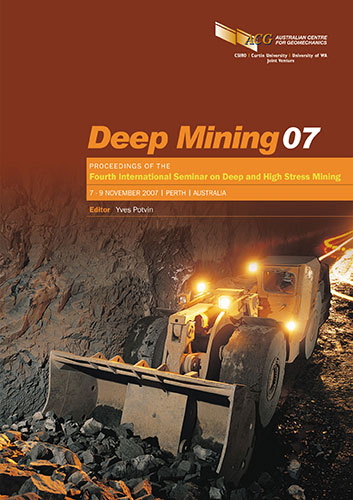Evidence Based Model Calibration for Reliable Predictions

|
Authors: Wiles, TD |
DOI https://doi.org/10.36487/ACG_repo/711_Wiles
Cite As:
Wiles, TD 2007, 'Evidence Based Model Calibration for Reliable Predictions', in Y Potvin (ed.), Deep Mining 2007: Proceedings of the Fourth International Seminar on Deep and High Stress Mining, Australian Centre for Geomechanics, Perth, pp. 3-20, https://doi.org/10.36487/ACG_repo/711_Wiles
Abstract:
This paper discusses how to quantify the reliability of numerical model predictions, ways to improve the reliability, and finally how to apply this knowledge. By comparing model results with actual mine response we can quantify the reliability of numerical model predictions. This reliability can be improved by refining our model. This may require an improved representation of the geometry, better estimates of the pre-mining stress state, fine-tuning of the material properties and implementation of more complex plastic constitutive response. We can readily assess how important each of these refinements is simply by seeing how much improvement in reliability each of these refinements provides. This allows us to determine what type of model we require and assess whether the increased cost of a more complex model can be justified. Once we have quantified the reliability, we can use probability theory to make predictions of future mine behaviour. The use of probabilistic prediction allows for direct cost benefit comparisons of various alternates to be more readily considered.
References:
Jamieson, M. (2007) Personal Communication, Senior Rock Mechanics Engineer, Xstrata Copper – Mount Isa Copper
Operations, Mt. Isa, Queensland, Australia.
Martin, C.D. (1997) The effect of cohesion loss and stress path on brittle rock strength. 17th Canadian Geotechnical
Colloquium, Canadian Geotechnical Journal, Vol. 34(5), pp. 698-725.
Wiles, T.D. and Kaiser, P.K. (1994) In situ stress determination using the under-excavation technique – I. theory. Int. J.
Rock. Mech. Min. Sci. Vol. 31, pp. 439-446.
Wiles, T.D. and Kaiser, P.K. (1994) In situ stress determination using the under-excavation technique – II.
Applications. Int. J. Rock. Mech. Min. Sci., Vol. 31, pp. 447-456.
Wiles, T.D., Villaescusa, E. and Windsor, C. (2004) Rock reinforcement design for overstressed rock using three-
dimensional numerical modelling. 5th International Symposium on Ground Support, Perth, Australia, 2004,
pp. 483-489.
Wiles, T.D. (2005) Rockburst Prediction Using Numerical Modelling: Realistic Limits for Failure Prediction Accuracy.
6th International Symposium on Rockbursts and Seismicity in Mines (RaSiM 6), Perth, Australia, 2005,
pp. 57-63.
Wiles, T.D. (2006) Reliability of Numerical Modelling Predictions, Int. J. Rock Mech. & Min. Sci. 43, pp. 454-472.
Evidence Based Model Calibration for Reliable Predictions T.D. Wiles
20 Deep Mining 07, Perth, Australia
© Copyright 2026, Australian Centre for Geomechanics (ACG), The University of Western Australia. All rights reserved.
View copyright/legal information
Please direct any queries or error reports to repository-acg@uwa.edu.au
View copyright/legal information
Please direct any queries or error reports to repository-acg@uwa.edu.au